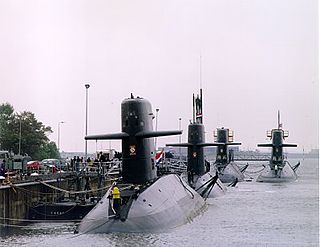
The Walrus-class submarine is the only submarine class currently in operation in the Royal Netherlands Navy. The boats have been in service since 1990 and are all named after sea mammals.

HNLMS Walrus (S802) was a Walrus-class submarine of the Royal Netherlands Navy. After a long delay following a serious fire during construction, the submarine entered service in 1992. Walrus was deployed both for naval exercises and in combat operations around the world. She was decommissioned in October 2023.

The Zwaardvis-class submarine ("Swordfish") is a class of conventional attack submarines that were built to strengthen the Royal Netherlands Navy. The Dutch government opted for the choice to not replace the two Zwaardvis-class submarines with either more Walrus-class submarines, or submarines of a new design.

The Holland-class destroyers were built for the Royal Netherlands Navy in the 1950s. They were the first major warships designed and built by the Dutch after World War II. In contrast to previous Dutch Navy practice the ships were named after provinces rather than admirals.
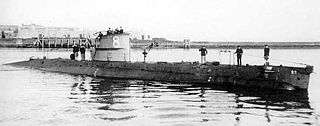
HMS H6 was a British H-class submarine of the Royal Navy built by Canadian Vickers & Co. during World War I.
The naval history of the Netherlands dates back to the 15th century. As overseas trade was a traditional cornerstone of the Dutch economy, naval defence was indispensable for the protection of commercial interests.

The Royal Netherlands Navy Submarine Service is a department within the Royal Netherlands Navy that is responsible for the deployment of Dutch submarines. It was established out of the Netherlands Torpedo Service on 21 December 1906, and merged with the Netherlands Mine Service on 15 July 2005.
The O 2-class submarine consisted of four submarines built by Koninklijke Maatschappij De Schelde in Flushing for the Royal Netherlands Navy. Used for patrols in the Dutch home waters. The class comprised O 2, O 3, O 4 and O 5. Its diving depth was 25 metres (80 ft); during trials with no crew on board a depth of 40 metres (130 ft) was reached.

The O 19 class was a class of two submarines, built for the Royal Netherlands Navy by Fijenoord, Rotterdam. The ships were designed as submarine minelayer for operations in both European and colonies waters. The class comprised O 19 and O 20 and were the first submarines in the world to be equipped with a submarine snorkel that allowed the submarine to run its diesel engines while submerged. The submarines diving depth was 100 m (330 ft). These units were very similar to earlier Polish Orzeł class, with a reduced torpedo battery and 10 vertical mine tubes fitted on each beam.

The O 21 class was a class of seven submarines, built for the Royal Netherlands Navy. The boats were still incomplete at the start of the German invasion of the Netherlands O 21, O 22, O 23 and O 24 were hastily launched and escaped to the United Kingdom. O 25, O 26 and O 27 were not able to escape and were captured by the German forces. The Kriegsmarine ordered the completion of the boats and they entered German service as UD-3, UD-4 and UD-5. The submarines' diving depth was 100 meters (330 ft).
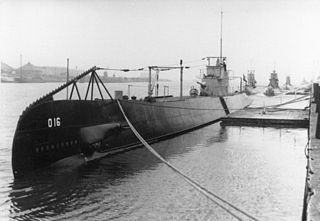
HNLMS O 16 was a submarine of the Royal Netherlands Navy that saw service during World War II. She was the first submarine of the RNN manufactured from high-quality Steel 52, with the ability to dive at a depth of 80 metres (260 ft).
HNLMS O 7 was a unique patrol submarine of the Royal Netherlands Navy for use in the home waters of Europe. The ship was built by the Maatschappij Fijenoord shipyard in Rotterdam. The submarines diving depth was 40 metres. O 6 was very similar to the O 7 and they are sometimes regarded as one class.
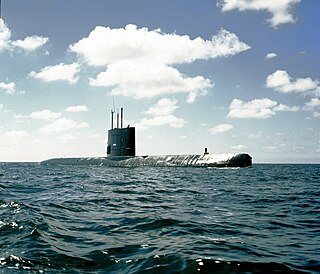
HNLMS Dolfijn was a Dolfijn-class submarine of the Royal Netherlands Navy.

HNLMS Zwaardvis (S806) was a Zwaardvis-class submarine of the Royal Netherlands Navy.
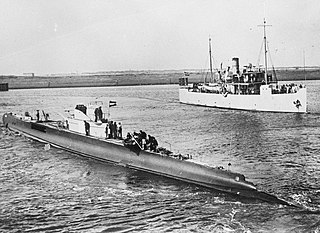
K XVII was one of five K XIV-class submarines built for the Royal Netherlands Navy. She served during World War II.
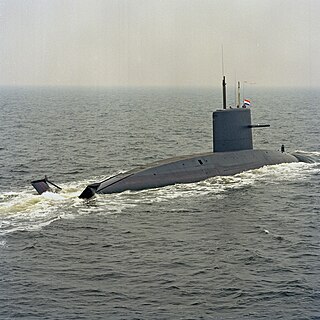
HNLMS Zeeleeuw (S803) is a Walrus-class submarine of the Royal Netherlands Navy. She entered service in 1990 as the first submarine of the Walrus class, after the intended lead ship, HNLMS Walrus, was delayed for a long period following a serious fire during construction. Zeeleeuw has been deployed both for naval exercises and in combat operations around the world. Furthermore, the submarine plays an important role by performing intelligence operations. The submarine has undergone a mid-life maintenance and upgrade program between 2014 and 2016, and is currently in active service.

HNLMS Dolfijn (S808) is a Walrus-class submarine of the Royal Netherlands Navy. She entered service in 1993 as the third submarine of the Walrus class, after HNLMS Walrus and HNLMS Zeeleeuw. Dolfijn has been deployed both for naval exercises and in combat operations around the world. Furthermore, the submarine plays an important role by performing intelligence operations.

HNLMS Bruinvis (S810) is a Walrus-class submarine of the Royal Netherlands Navy. She entered service in 1994 as the fourth and final submarine of the Walrus class, after HNLMS Walrus, Zeeleeuw and Dolfijn. Bruinvis has been deployed both for naval exercises and in combat operations around the world. As of December 2015 the submarine was in active service.
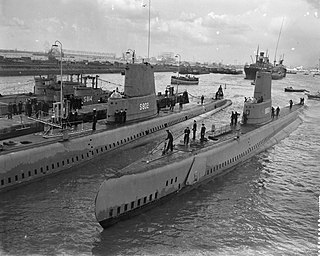
The Walrus class was a class of two submarines that served between 1953 and 1971 in the Royal Netherlands Navy. They were former Balao class submarines that were loaned to the Netherlands by the United States under the Mutual Defense Assistance Program (MDAP).























